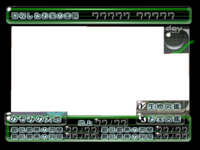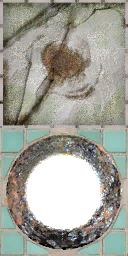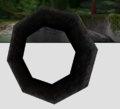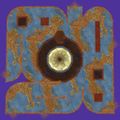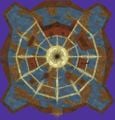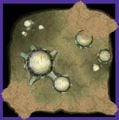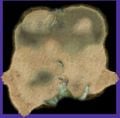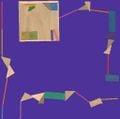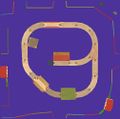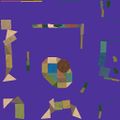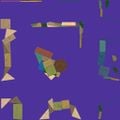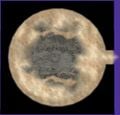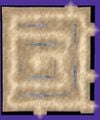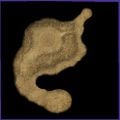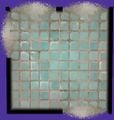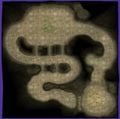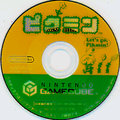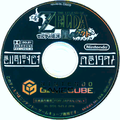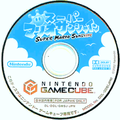Unused content in Pikmin 2
|
This article or section is a short summary on unused content in Pikmin 2. |
|
This article is a stub. You can help Pikipedia by expanding it. |
Pikmin 2 has a vast amount of unused content inside the disc, although most of it is text, cut treasures, and unused models.
Unused graphics[edit]
Piklopedia icon[edit]
A dummy Piklopedia icon can be found amidst the regular Piklopedia icon textures, in the game's files. Presumably, it was used during development to identify enemies with no icon at the time.
Mappy[edit]
Two icons originally from Mappy remain unused. Judging by the internal filename, j2dtest.arc, the initial inclusion was most likely for testing.
Title screen logos[edit]
There are two unused title screen logos.
The word "ピクミン?", in blue chrome.
Map editor[edit]
Unused icons of a map editor presumably used by the developers for designing the areas.
[edit]
A texture for the preliminary layout of the world map is in /new_screen/jpn/worldmap.szs. The entire HUD was later rearranged and redone, and a blue background was added.
Waterwraith dummy texture[edit]
There is a dummy texture in the Waterwraith's model. Its look is created with frame buffer shaders, meaning that this underlying texture is not usually seen.
Obscured Perplexing Pool texture[edit]
This texture that combines two textures is used, but in each case it's either distorted or portions of the texture aren't used – the player never gets to see both parts of the texture clearly.
The bottom part of this texture, resembling a drain pipe clogged with grease, is located under the Shower Room's entrance, but it cannot be fully seen because the cave entrance covers most of the texture. It can be seen in the Piklopedia in the same spot, but even then it's warped by the water texture above it and the Piklopedia's bloom filter; not to mention that the level model is actually an almost completely different model.
The top part of this texture is seen on the chipped parts of concrete/tile in the same area, but only portions of it can be seen at a time. In the two cases where it's facing upwards, the middle section is normally covered by a metal pipe, and for the chipped concrete at the landing site, the surrounding tile part is not visible. In the other case when it's used in the crack in the Shower Room's entrance, only a quarter of it is used, and part of it's at an extremely narrow slant, making it hard to look at clearly.
Unused maps[edit]
There is a single unused level in Pikmin 2, titled newtest. It has a Piklopedia version in another file, which is missing the section of the map with footstep sounds. It has multiple unused layouts in /user/Abe/map/newtest/nonloop, three of which specify enemies that are planned to spawn in certain areas, as dictated by a "readme" file found in the same directory. It seems to be a test map, based on its title and its contents, which include organized slopes, water, and clusters of enemies and objects. It overall has a basic, flat garden environment similar to the Perplexing Pool.
Numerous Bulborbs and other clusters of enemies. They could have been used for performance tests.
Unseen area geometry[edit]
A large amount of unseen geometry can be seen out of bounds in most areas through hacking in Pikmin 2. In most cases, this indicates usage of a copy and paste feature on the modeler's modeling program, although in some cases, it implies slightly different area design at one point in development.
These include:
- A floating triangle under the buried plate in the Awakening Wood and its Piklopedia version. Its presence is likely related to the modeling process for the buried plate, since it has the texture of the plate itself.
- Petals found underground in the Awakening Wood.
- The adapters on the metal pipes in the Perplexing Pool having bottom geometry and back geometry.
- A tile block found near the landing site in the Perplexing Pool has an unusual shape underground, indicating that it might have been rotated differently earlier in development.
- A roof shingle buried in the Perplexing Pool having extra geometry that goes unseen underground.
- A wooden frame going much deeper than what is seen normally in-game.
Unused text[edit]
readme.txt[edit]
An unused readme.txt found in /user/Abe/map/newtest/nonloop indicates that the layout files for newtest found in the same directory as the file likely specify which enemies are to spawn in certain areas.
Curiously, 2-2.txt specifies that an enemy with the ID of 39 would spawn in the Awakening Wood. Attempting to spawn the enemy with the ID of 39 crashes the game, as it does not exist. Additionally, the file for the Perplexing Pool, 3-3.txt is absent. All of the objects placed in these layouts are in sloppy rows, so they are not early layouts of areas. It is unclear which of the enemies listed spawned in caves or the overworld.
0-0.txt…プラントテスト
1-1.txt…チュートリアル分布
2-2.txt…フォレスト分布
3-3.txt…ヤクシマ分布
4-4.txt…ラスト分布
- プラントテスト? is "plant test". This doesn't appear to correspond to any known area.
- チュートリアル分布? reads: "tutorial distribution", referring to the Valley of Repose.
- フォレスト分布? reads: "Forest distribution", referring to the Awakening Wood.
- ヤクシマ分布? reads: "Yakushima distribution", referring to the Perplexing Pool.
- ラスト分布? reads: "Last distribution", referring to the Wistful Wild.
Unknown Piklopedia entry[edit]
An unused Piklopedia entry for an unknown enemy. It may have been an early entry for the Burrowing Snagret (or at least a relative of it), based on the fact that it "stretches its neck" and does not chase Pikmin, similar to the Burrowing Snagret's way of attacking.
Stretches its neck to look for
prey. When it finds Pikmin, it
gobbles them up instead of
chasing them.
Unknown Treasure Hoard entry[edit]
An unused Treasure Hoard entry for an unknown treasure.
A hard, shiny rock.
Highly valuable.
Makes an excellent gift.
Test messages[edit]
Unused text, most of which appears to be test messages and debugging text.
Test Message 9995
Test Message 9996
AquickbrownFoxJumpsoverthelazy
damedayo!
Oh! no!
The following error message fires under certain conditions in the area selection menu's code. Its meaning is unknown; it likely refers to a development in-joke.
MOC = Mouse on Cars!
The following error message fires under certain conditions in sysShape (usually when the game crashes), which is an internal manager related to preloading and setting up models in Pikmin 2.
go to hell!
ID messages[edit]
These messages appear to be titles of unknown test areas in radar screens, as the title shown for newtest in the radar is "Test Area (ID 8394_03)".
Under Construction (ID9999)
This message was moved
(ID 1005)
This message was moved
(ID 1006)
Test Area (ID 8394)
Test Area (ID 8394_01)
Test Area (ID 8394_02)
Test Area (ID 8394_03)
Developer comments[edit]
All files for parameters, cave generation files, and area generation files are presented in human-readable format. They also have unseen developer comments in Japanese and English, to easily identify the different parameters, sections, and values.
Internal naming oddities[edit]
All content in Pikmin 2 has internal names that cannot be seen in-game, like unused text. The naming of these files sometimes contains leftovers or hints to cut content early in development:
- The developer comment for the lone Burrowing Snagret in the Valley Of Repose is "ヘビガラス埋まりお宝?" which roughly translates to "Burrowing Snagret filled with treasure", hinting that the Pink Menace may have been once inside the Snagret.
- The names of many files used for lighting in caves indicate that a sublevel was deleted from the final cave:
- The first floor of the Snack Pit uses a lighting file called
Key_light_lv1.ini, and there's an unused lighter version of the same file namedKey_light_lv0.ini. The presence of this indicates a floor was cut from the Snack Pit in the final game.
- The first floor of the Snack Pit uses a lighting file called
Unused music[edit]
The Valley of Repose has an unused Burgeoning Spiderwort track, but no Burgeoning Spiderworts are found in that area. However, if Burgeoning Spiderworts are hacked into the Valley of Repose, the unused track will play.
Other unused songs include:
| Track | Notes |
|---|---|
book |
Unknown. Possibly an early track for the Piklopedia / Treasure Hoard screens, or the file selection menu. |
Camera |
Meant for the unused camera tutorial. |
ff_o_win |
Likely meant for a 2-Player Battle result screen. This variation is for Olimar winning. |
ff_l_win |
Likely meant for a 2-Player Battle result screen. This variation is for Louie winning. |
ff_draw |
Likely meant for a 2-Player Battle result screen. This variation is for a draw game. |
ff_akirame |
"Akirame" means "give up", so this could have been used when exiting a cave, or Challenge Mode. |
ff_onyonboot |
Another track used in an unused cutscene. The Onions are always above ground, meaning this sound goes unused. |
Unused scenes[edit]
Much like in the first game, each Onion was to be found dormant, and had their own "boot up" cutscene. The Red Onion has a textbox that automatically closes itself as the textbox points to a message that doesn't exist.
Unused caves[edit]
A cave entrance leading to an unused cave exists in the Perplexing Pool just to the right of the Red Onion's landing site, but only on day 1. It is completely impossible to get to the Perplexing Pool on day 1 without hacking.
This cave is known as caveinfo internally, and is composed of earlier versions of sublevels used in other caves, with some sublevels with unique layouts being totally cut from the game and remaining here. It has 34 floors and uses the Petrified Heart, Regal Diamond, and Tear Stone as placeholders for treasures in most of its sublevels.
Cave units[edit]
Unused cave unit models[edit]
The caves are made up of randomly laid out map units (located on /user/Mukki/mapunits/units, with each sublevel having a specific one. These units are unused:
| Image | Name | Description |
|---|---|---|
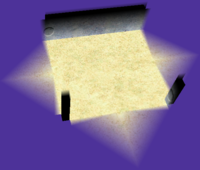
|
item_way3_conc | A concrete three-way crossing, presumably with an item in the middle, judging by the name. The sand texture is different compared to the sand texture in the final game, and appears to be a leftover from an earlier stage of development. |
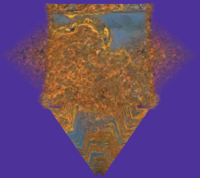
|
item_way3_metal | A metal three-way crossing, presumably with an item in the middle, judging by the name. |
| Visually the same as the used dirt three-way crossing | item_way3_tsuchi | A dirt three-way crossing, presumably with an item in the middle, judging by the name. |
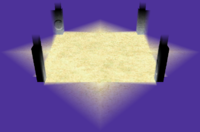
|
item_way4_conc | A concrete four-way crossing, presumably with an item in the middle, judging by the name. The sand texture is different compared to the sand texture in the final game, and appears to be a leftover from a earlier stage of development. |
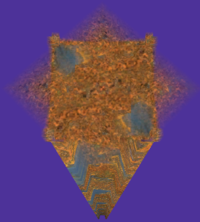
|
item_way4_metal | A metal four-way crossing, presumably with an item in the middle, judging by the name. |
| Visually the same as the used dirt four way crossing | item_way4_tsuchi | A dirt four-way crossing, presumably with an item in the middle, judging by the name. |
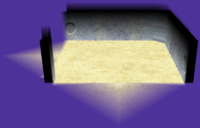
|
item_wayl_conc | A concrete turning corridor, presumably with an item in the middle, judging by the name. The sand texture is different compared to the sand texture in the final game, and appears to be a leftover from a earlier stage of development. |
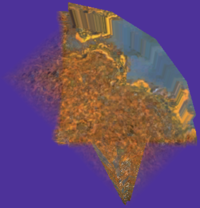
|
item_wayl_metal | A metal turning corridor, presumably with an item in the middle, judging by the name. This metal cave unit has unusually high walls; this change can be seen in a prerelease screenshot of 2-Player Battle, which depicts the entire metal cave unit set with high walls. |
| Visually the same as the used dirt turning corridor | item_wayl_tsuchi | A dirt turning corridor, presumably with an item in the middle, judging by the name. |
| Visually the same as the used 4-exit circular dirt room | room_cent_4_mat_tsuchi | A dirt circular room with four exits. A near-duplicate of room_cent_4_tsuchi, but differing on layout.txt. |
| Visually the same as the used metal zigzagging corridor room | room_nobo1_4_metal | A metal zigzagging corridor room, near duplicate of room_nobo2_4_metal, but differing on layout.txt. |
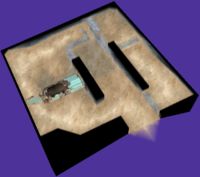
|
room_north4x4k_1_bomb_conc | The same as the room that sublevel 2 of the Submerged Castle ends in, but part of the tube is above ground. The "bomb" part of the internal name probably refers to a puzzle involving an chain of bomb-rocks using this cave unit in a sublevel of an unused cave. Link to the puzzle in question. |
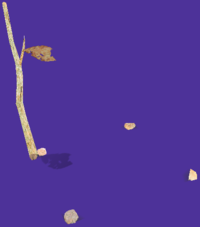
|
way4_kusachi | A four-way crossing used in gardens, featuring a twig with a leaf that casts a shadow. While used on almost all garden floor layouts seen in-game, no used floor layout ever has four paths that cross, so this unit unexpectedly goes unused. |

|
way6_tsuchi | This unit belongs on the dirt-type levels (_tsuchi), and is meant to split a single path into five different ones. This unit is only incorporated on the list of all units, but that list is referenced by no cave. Even though it looks like it contains all of the necessary map unit data, its strange floor texture (which is similar to the soil textures in the first sublevel of the Snagret Hole) is further indication of its exclusion from the game.
|
Pointless cave unit exits[edit]
Caves are made out of multiple cave units, each with their own exit points. The game then connects these units during sublevel generation by connecting exit points. Some cave units have exit points that are useless in sublevel generation, because the resulting sublevel is always the same in-game, showing no randomization. This is because every time the sublevel is generated, it can only ever use the same cave units in the same way, so these rooms always have the same dead-end units connected to them. In addition, there is a property that controls the corridor-to-room ratio, with 0 resulting in only dead-end units spawning and no corridors, and 1 being lots of corridors connecting exit points. Where these cave units appear, this ratio is set to zero, so corridors cannot generate, resulting in the only thing to connect to them being the dead-ends. This would be functionally identical to a sublevel using a single cave unit with the dead-ends as part of the model. Shown below are the cave units where this issue arises:
Of special note is the last sublevel of the Dream Den, which can actually show randomization in the sublevel visuals, since there are two different dead-end units that can be used for that sublevel. Normally, all of the player's attention gets diverted to defeating the Titan Dweevil, carrying back the treasures, and exiting the cave, instead of the type of dead-end unit used when the sublevel was generated.
Cave unit name oddities[edit]
The majority of "room" styled cave units are named with this pattern, with a few exceptions: [type]_[details]_[exits]_[style]
Where "details" includes the "layout ID" of the unit, linking it with other units with the same layout in different styles, and the unit dimensions. For example: room_4x4d_4_conc is a room, that is 4 units wide and 4 units long, is a "d" styled layout (connecting it with room_4x4d_4_renga and room_4x4d_4_tile, which share the same layout), it has 4 exits, and it is in the concrete theme.
Some cave units have abnormal names that do not match up with the actual model or imply other details, listed below. These naming oddities are likely leftovers from earlier stages of development, where hypothetically, those names were correct in relation to the cave unit.
While there are "4x4" layout IDs for letters of the alphabet up until O, there is no "4x4n" or "4x4m" shape that exists. A cave unit with a "3x4n" layout ID does exist, however, but the cave unit that uses that shape is the only lettered 3x4 cave unit. There is also a "3x3m" ID that is used in the snow and concrete sets, but that ID too is the only lettered 3x3 ID.
Of special note is room_boss_1_tsuchi and room_hebi12x12_1_tsuchi; the ends of both units differ in texture from the rest of the unit, suggesting that the cave unit originally had an exit in line with their internal names, but then later had a dead end unit stitched onto the model.
Unused lighting[edit]
Jyouu_light[edit]
Probably used for the Hole of Beasts at one time in development. Jyoou translates to queen.
Sirohana_light[edit]
Sirohana translates to white flower, so these lighting settings may have been used for the White Flower Garden.
Muraon[edit]
While muraon_light files 1-2 and 4 are used, these variants are not.
Key light[edit]
A slightly lighter version of the lighting used in the Snack Pit, whereas the final version uses key_light_lv1.ini.
Head beacon lamps[edit]
These lighting files use an earlier format than the others, so the only way to get these to work right is to import the RGB and light settings into a different file. It's possible that these settings were meant for Olimar and Louie, who would light the caves with their tracking beacons. Or they could just be test files.
Interestingly, a slightly modified version of this leader-specific light casting was used in Pikmin 3, albeit with an added alpha channel with bumpmap-tracking to reduce the intensity of the color based on where the leader is standing.
Unused treasures[edit]
There are some unused treasures in Pikmin 2's game data. Some of them include the discs for Japanese Nintendo GameCube games: Pikmin, The Legend of Zelda: The Wind Waker, Luigi's Mansion, and Super Mario Sunshine.
Pikmin 2-e[edit]
- Main article: e-Reader.
The Japanese version of Pikmin 2 has e-Reader compatibility. Although this was removed for the overseas versions of the game, the menus are still present in the game's files.
Ignored cave settings[edit]
- Some sublevels have data to play a certain song, but end up playing a different one in-game:
- In all sublevels of the Submerged Castle, the track Hole of Heroes should play, but the cave's hardcoded logic makes Submerged Castle play instead.
- In Dream Den sublevel 9, the track Hole of Heroes should play, but the rest sublevel hardcoded logic makes Rest play instead.
- Some cave units are defined to be used in sublevels, but the game can never generate a sublevel that uses them:
- In Emergence Cave sublevel 1, the list of cave units includes corridors, crossways, and dead ends, even though the sublevel only ever contains 2 circular rooms facing one another.
- In Dream Den sublevel 14, the list of cave units includes pipe corridors, pipe crossways, and a pipe dead end, even though the sublevel is just the main room and a concrete dead end.
- All garden-themed sublevels include the unused four-way garden cave unit with a twig, but all those sublevels generate in such a way that it can never be used.
- Some sublevels define in their data that certain objects should spawn, but the sublevel can never generate in a way that accommodates them:
- In Cavern of Chaos sublevel 2, 1 green Glowstem is meant to spawn, but none can ever appear.
- In Cavern of Chaos sublevel 4, 24 bomb-rocks are meant to spawn, but only 21 can appear at most.
- In Dream Den sublevel 8, 2 Fiddleheads are meant to spawn, but none can ever appear.
- In Cave of Snarls sublevel 2, 99 Glowstems are meant to spawn, but it is only possible for 28 to appear.
- In Breeding Ground sublevel 1, 20 Dandelions and 60 Margarets are meant to spawn, but it is only possible for 16 Dandelions to appear and 0 Margarets.
- In Sniper Room sublevel 1, 2 Armored Cannon Beetle Larvae are meant to spawn, each with a Tear Stone, but it is only possible for 1 Armored Cannon Beetle Larva (with its Tear Stone) to appear.
- All sublevels of the Submerged Castle specify that the Waterwraith carries the Professional Noisemaker inside. The treasure cannot be obtained normally in the first four sublevels however. In addition, the Treasure Gauge won't detect this treasure, and will shut off if all the other treasures in the sublevel are collected.
- The game files state that the skyboxes used for the 8th sublevel of the Dream Den, all sublevels of the Hot House, and Collector's Room is a skybox called "vrbox". "vrbox" is not a valid skybox, but is the name of the folder containing all the skybox models. Additionally, all levels of the Green Hole use a skybox known as "f010". Since "vrbox" and "f010" do not exist, the game uses no skybox as a result.
Other[edit]
- The text in the opening video is overlaid on top of the actual video in Pikmin 2, leaving a small fraction of pixels in the video unused. Video without the text here.
- There is a unused feature for electrical wires in 2-Player Battle to change color and element based on the Pikmin attacking it; Red Pikmin turn the electric wire's lighting red and set Blue Pikmin on fire, while Blue Pikmin turn the electric wire's lighting blue and apply the drowning effect to Red Pikmin. This also causes them to constantly be on and never turn off.
- Pellets, nectar, spray nectar, and Pikmin seeds (of a random color) can be spawned in a generation file for an area, but these features are unused. The generation file of newtest spawns blue pellets in the ramped water section, but that too, is unused as newtest cannot be accessed in normal gameplay.
- The file system in Pikmin 2 has a section of files containing archives used by the game, all named after developers. Two of these folders are empty:
MorimuraandOgawa, probably short for Naoya Morimura and Yuzuru Ogawa. - An archive called
meckis present in the folder for cave skyboxes, but all the archive contains is an empty folder called "meck". - The game has a failsafe for where White Pikmin are unlocked but Purple Pikmin aren't, where the screen to select the amount of White Pikmin just simply shows up. This isn't seen in normal gameplay without using a glitch to skip Purple Pikmin.
- Pikmin can die by managing to fall out of an area, similarly to The Forest Navel. It isn't possible to see Pikmin die by this method in normal gameplay because there are no bottomless pits in areas in Pikmin 2.
- There are waypoints for carrying objects out of the cave unit for the Titan Dweevil's arena, but Pikmin are never seen carrying objects out of the room in-game.
- The Man-at-Legs while dormant is affected by gravity. This can not normally be seen in the game.
- The Waterwraith is set to hold the Professional Noisemaker on all sublevels of the Submerged Castle. It is completely impossible to bring non-Blue Pikmin into the Submerged Castle, as the game is coded to not count non-Blue Pikmin when bringing Pikmin into the Submerged Castle, so this property is pointless in normal gameplay.
- Gas pipes have a feature to turn on and off on a loop. They are set to be spewing for 3 seconds, but because they are set to be off for 0 seconds, the entire on-and-off feature has no purpose. This is also not the result of copying the data from the fire geyser, since that object uses different durations (2.5 seconds for being on).
- Unmarked Spectralids have 200 health points but die on one hit. Likewise, Honeywisps have 99999 health points but also die in one hit.
- In Pikmin, there is an unused feature that makes Pikmin get thrown higher the longer the Pikmin is held. This feature has no effect on gameplay since the normal height values and the "fully charged" height values are the same. In Pikmin 2, these values still exist, and are still the same for the normal and full charge amount, but the code for the feature itself has been removed.
- Enemies in Pikmin 2 have set ID numbers, and are spawned using the ID number that is assigned to the enemy. Four of these numbers,
39,64,82, and100are never used; they crash the game when spawned. This is because the files for39and64were deleted, and ID numbers82(internally,Pom) and100(internally,UmiMushiBase) appear to be template files for variants of Candypop Buds and enemies in the mollusking family, respectively.- Interestingly,
82appears after all of the ID numbers for the specific Candypop Buds, which are numbers3through8. The ID number for the Ranging Bloyster appears much later in the list as71(internally,UmiMushi) while the ID for Toady Bloyster is101(internally,UmiMushiBlind), so it's possible that some of the ID numbers shifted around during development. Additionally, the enemy that has the ID of39is set to spawn in a unused layout file for newtest and is referred to as "フエフキムシ?, lit.: "Flute Player Bug"" in comments, which is similar to the Antenna Beetle's internal name. This enemy would be able to spawn in the Awakening Wood as dictated by areadme.txtfile found in the same directory.
- Interestingly,
A unused test cave for the Giant Breadbug (
パンモドキテストcaveinfo).
See also[edit]
| Prerelease information | |
|---|---|
| General info | Pikmin • Pikmin 2 • Pikmin 3 • Pikmin 4 • Hey! Pikmin |
| Unused content | Pikmin • Pikmin 2 • Pikmin 3 • Pikmin 4 • Hey! Pikmin |
| Unreleased games | Adam and Eve • Patent US7762893 • Stage Debut |








